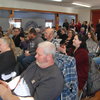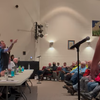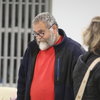Finding history in the details
The Enterprise — Marcello Iaia
Hal Miller has written two books on the German heritage of Berne and Knox. One of the books gives the history of these families, original settlers of the Helderbergs: Ball, Dietz, Weidman, Shultes, Fischer, Haverly, Bassler, Leib, Saddlemire, Fetterly, Swart, Casman, Post, Engel, Salsberger, Ecker, Schaeffer, Warner, Zeh, Steomer, Becraft, and Hochstrasser. He plans to sell the book locally; any profits will be used to post genealogical records online.
— 1720 portrait by Sir Godfrey Kneller
Robert Hunter was governor of New York from 1710 to 1720, and oversaw Palatine refugees who made tar from pine resin to seal British ships. He was angry when they left without his permission to settle land they had been promised in Schoharie. Hunter, a Scot born in 1664, had in his youth been apprenticed to an apothecary but ran away to join the British Army, becoming an officer. In his first address, of fewer than 300 words, to the Assembly, Hunter said, “If honesty is the best policy, plainness must be the best
Enterprise file photo — Tyler Murphy
A great barrier to early settlement: The Helderberg escarpment, with its sheer cliffs, and poor soil for farming, kept the area a wilderness long after the Dutch had settled the Hudson Valley in the 1600s. German-speaking Palatines settled the area on top of the escarpment now known as Berne and Knox. They were promised land in Schoharie but, in exchange for passage from England, had to work first near what is now New York City, making tar from pine resin to seal British ships.
— From Harold Miller
The Dietz Massacre was painted by Jacob Dietz, the younger brother of Captain William Dietz, who is shown, at front left, being taken captive by Indians during the Revolutionary War. The massacre took place in Berne on Sept. 1, 1781. The marauders were led by a British soldier, targeting Deitz because he was a local militia captain in strong support of the Revolution. Harold Miller saw the painting online, which is in the Greater Oneonta Historical Society Museum, and immediately recognized the scene, informing the curators of its history. “They didn’t realize it was a real massacre,” said Miller, who details the massacre in his soon-to-be-published book.
Harold Miller lives in Mexico but has deep roots in the Hilltowns. Through laborious research, using modern methods — the Internet drives his work, supplemented by a library of just 20 books — Miller has rewritten Berne’s early history.
He plans to publish two books shortly — one on the German heritage of Berne and Knox, and the other, a companion volume, tracing the history of individual families from those places.
Miller, the second oldest of nine kids, was raised on a dairy farm in East Berne at the foot of Cole Hill. It seemed to him and his older brother, Ralph, now Berne’s town historian, that they were related to half their classmates at Berne-Knox.
It turns out they were.
“At first, Ralph was criticized by the Albany County historian for doing genealogy. But, without genealogy, I never would have found out the history was wrong,” said Miller. “It got me interested…
“I took it back to 1710. The settlers were all German-speaking,” said Miller, noting that the Reformed churches in the Hilltowns were Deutch (or German), not Dutch.
Miller discovered that the long accepted view of Berne’s history — that seven families settled Berne in the 1750 — was not true.
The account in “Our Heritage,” published in 1977 by the Town of Berne Bicentennial Commission, states, “It was 1750 when Jacob Weidman led a small band of settlers along an old Indian trail through the Helderbergs.”
Miller says that account was taken from Howell and Tenny’s The History of Albany County, written in 1886. Miller’s study of vital records reveals, instead, that the early Berne families arrived individually over a period of more than two decades.
Some local historical society members, he said, are angry; one told him he is “trying to change the history of Berne.” But, said Miller, “I’m trying to correct it.”
In his first book, Miller traces the settlement of German-speaking people back to 1710 and details a complex series of events, stretching over decades, that led to the European settlement of the Hilltowns.
History is often personal for Miller. For example, he notes that, in the 1790s, English-speaking settlers started coming to the Helderbergs because their farms elsewhere were already overcrowded.
“It’s a similar history to my family, with five boys,” said Miller. “Four tried to live on the farm. They didn’t make enough. It was great for one person.”
Miller alone, among his siblings, has left the area. The other eight settled within 25 miles of the farm where they were raised, he said.
Why did he leave?
“Basically because I’m gay,” he said. “I didn’t feel comfortable. It wasn’t a great place to be gay.”
Miller left Berne for Cornell University where he studied agricultural economics. He went on to work for the National Park Service and became a budget officer for the country’s capital region, which includes the White House, the Washington Monument, and the National Mall.
While living in Washington, D.C. Miller fell in love with Ed Davidson, who worked for the Smithsonian Institution. After Miller had been with the park service for 20 years, the couple decided to try something new and moved to California to work in real estate when they discovered the charm of Oaxaca, Mexico where they’ve lived ever since.
Miller and Davidson have been together for 44 years, and got married four years ago, on Sept. 11, once same-sex marriage became legal in Massachusetts. The ceremony was held at the Village Inn in Lenox, Mass.
Miller, 73, now spends eight hours a day at his computer in Oaxaca, researching Hilltown history and genealogy. In addition to writing books — he has another one underway on Hilltown men who fought in the Civil War — Miller in 2001 launched the Berne Historical Project website, at www.Bernehistory.org, where residents and far-flung descendents can share information and history.
Dataflow on Fuller Road will print his books; any profit will be used to copy and post online Euretha Stapleton’s records. Stapleton was the long-time Berne historian before Ralph Miller. “She was a genealogist and documented individual families of Berne. People will be able to read these records. I’m not keeping any of the money,” said Harold Miller, adding, “People ring up Ralph all the time, looking for family history.”
A new foundation
Miller’s book on the German heritage of Berne and Knox starts with the early Dutch settlement of the Hudson Valley and gives a detailed history of the Palatines’ convoluted journey to Schoharie.
Other chapters cover the settlement at Beaver Dam, churches in the Helderbergs, cemeteries and family burying grounds, and the militia.
Much of the Hudson Valley had been settled by the Dutch in the 1600s but the land above the Helderberg escarpment remained wilderness because of its poor soil and inaccessibility.
The first Helderberg settlers were not Dutch, as many assume, but German speakers from the rich river-bottom land along the Rhine. They lived there before Germany was a nation, when the land was governed by separate fiefdoms.
Even the reason for the Palatine exodus after the Protestant Reformation was misunderstood, Miller found. “They didn’t leave for religious reasons. It was the economy, stupid,” said Miller, making a play on Bill Clinton’s campaign quip.
“The government raised taxes to pay for religious wars,” said Miller. That, combined with burned barns and ruined vineyards led to widespread hardship, causing the Palatines to migrate first to Holland and then to England.
“The winter of 1709 was so bad, it killed their cattle and their apple trees. It broke their backs. There was nothing for them to eat,” said Miller. “They left at once.” Both Catholics and Protestants made the journey.
At first, the Londoners welcomed them, setting up refugee camps for the Palatines to live in. But, when they provided cheap labor, taking jobs from Londoners, they were attacked.
A plan was hatched to ship the Palatines to New York where they would make tar from pine resin to waterproof British ships. Toward the end of December 1709, about 3,300 Palatines were packed into the holds of nine ships; they stayed in the crowded and unsanitary confines until setting sail in April 1710; hundreds died of typhus.
The ships arrived in New York harbor in the summer of 1710 and the refugees were isolated in tent camps on an island in the Hudson. Church records of refugee marriages in 1710 show about half were between widows and widowers.
“A lot continued to suffer and die,” said Miller. “The widows and widowers had to marry each other, or who would bring up the children?”
That fall, Governor Robert Hunter sent a survey team to the Schoharie Valley, and the Mohawks gave land there to Queen Anne for a Christian settlement. Hunter accepted the gift of land but decided it didn’t have suitable pines so, instead, about 1,200 Palatines were settled in camps near the Hudson near New Amsterdam. Each adult was allotted a third of a loaf of bread and a quart of low-grade beer daily.
By the spring of 1711, the Palatines were close to rebellion, demanding the land in the Schoharie Valley. Their rifles were confiscated and they were forced to remain in the work camps.
“They got very disgusted and wanted to get to Schoharie…The Indians had given land in Schoharie to Queen Anne for the settlement of German speakers,” said Miller. “The British took away their weapons and put guards up to keep them working.”
With a change in British government, the new government wasn’t interested in the pitch-pine project. So Governor Hunter put his own money into keeping the project going. He paid for beer and bread for the workers for almost a year before he ran out of money.
That was in September, with winter on the horizon. Some of the Palatines moved to Pennsylvania and others to North Carolina; about a quarter decided to go to Schoharie. “They called it the Promised Land.” The meaning was literal.
The Indians were agreeable since they had already sold it to Queen Anne, said Miller.
In October 1711, one-hundred-and-fifty families left immediately. “They weren’t allowed to take farm implements, cattle, even their guns,” said Miller. They pulled their few possessions, by hand, on sledges with iron runners.
They began their journey in what is now Dutchess County and traveled up the Hudson River. “They settled near Altamont for the winter,” said Miller.
A road went around the Helderberg escarpment, west of Altamont, up to Knox, then to Gallupville, and on into Schoharie. “They followed an Indian trail,” said Miller. A third of them went that winter to Schoharie with nothing to eat but what they could kill or gather from the woods,” said Miller, or get from the Indians.
To make homes, they dug into the ground a couple of feet and then built, with logs, shelters that stood two or three feet above ground. The pitched roves were covered with tree branches or deer hides.
“It was a terrible winter,” he said. Those who didn’t go to Schoharie stayed near where Altamont is today which, said Miller, was “not quite as bad — they had the help of the Dutch settlers.”
In March 1712, a late snow fell and the Altamont families immediately took off for Schoharie, since it was easier to pull their sledges on snow and they wanted to be ready for spring planting.
“Governor Hunter was very angry they had left without permission…Germans are very stubborn people, and they refused to leave the lands they had settled,” said Miller. “After 15 or 20 years of arguing with the governor and his successors, three of the settlers went to Britain to plead their case to stay in Schoharie. The court decided they would be given land in the Mohawk Valley.”
Some left for the Mohawk Valley. Others bought land in Schoharie and stayed there while still others came to Berne and Knox, settling in 1730 along the trail there. Others pulled their sledges to settle in West Berne.
Miller found genealogy researched by William Barker on early Schoharie settlers. “Because there was no church in Berne, he included Berne people, too, because they were baptized and married in Schoharie,” said Miller.
Other revelations
The unsettled land to the east of Schoharie in Albany County, said Miller, seemed to the new homesteaders to be theirs for the taking. “Since they were settling from the west, by the back door, so to speak, the Van Rensselaers may not at first have realized their land was being ‘invaded,’” Miller writes.
He goes on at length to describe the feudal patroon system, based on tenant farmers paying rent, and he painstakingly traces the local lineage of the Van Rensselaer family.
Miller discovered, through his research, that hundreds of Helderberg farms were without leases. “I took a detailed look at the VAN Rensselaer family history,” he said. “Two became patroons at age 5,” he went on. “I realized how rich they were. Some wives weren’t able to run the whole manor themselves….
“They had so much money coming in, they didn’t really need more from the Helderbergs. It was just too difficult to get leases. It was better if land was cleared. They figured it was better off just to let the settlers improve the land… It occurred to me this is the true story. They didn’t have time to do it.”
In writing about the militia, Miller states that colonists from the time of the earliest settlements — decades before the Revolution — were required to form companies of militia for their own defense; all male inhabitants from the age of 15 to 55 were legally obligated to be enrolled in militia companies.
The only noteworthy incident that occurred in Beaver Dam during the Revolutionary War was the massacre of the family of Captain William Dietz, a leader of the local militia who was strongly in support of the Revolution. The Dietz Massacre is a well-known bit of local history.
Miller’s account is at once detailed and riveting. Again, he has a personal connection to the history.
“We’re descended from three of the seven original Dietz settlers,” said Miller.
Captain Dietz and wife and their four young children lived on his parents’ farm outside of the protective Switzkill stockade.
“The reason for choosing the Dietz family as the target for the massacre is obvious,” writes Miller. “It was to terrorize the local populace. If the family of the captain of the local militia was not safe, no one was safe.”
On Sept. 1, 1781, the Dietz farm was attacked by Indians led by a British soldier. Captain Dietz was taken captive and, in front of his eyes, his elderly parents were massacred and scalped, as were his wife and four young children along with a Scottish servant girl.
Miller quotes from letters written to Governor George Clinton, one on Sept. 3 and the other on Sept. 7, describing the massacre.
Captain Dietz died soon after, held captive at Fort Niagara, under British command. A fellow captive reported that Dietz “appeared heart-stricken and in a decline, under which he sunk to the grave not long after.”
A Scottish hired hand, age 13 or 14, John Brice, and his visiting 11-year-old brother, Robert, were also taken captive and then raised by Indian families who had lost children during the war. Robert Brice was then sold by his Indian captors to the Scottish captain of a sloop on Lake Erie.
At the end of the war, he escaped the ship and managed to return to his parents in the Helderbergs. His adventures, as told by Brice to Josiah Priest in his 1836 book, Stories of the Revolution, are posted online at the Berne Historical Project Site.
Miller found a painting online owned by the Greater Oneonta Historical Society. The painting has a backdrop of dark smoke billowing from burning log buildings while in front, Native Americans wearing buckskins and feathered headdresses, round up several men in European garb. On the ground between lay slain bodies.
Miller recognized the scene right away from the frontispiece of Priest’s 1836 book, a depiction of the Dietz Massacre.
Miller knew it was painted by Jacob Dietz, the younger brother of Captain William Dietz, shown being taken captive by the Indians along with the Brice boys.
Miller could identify even the slain bodies — William’s father, Johannes Dietz, in front of the burning barn to the right; and, towards the center, the bodies of his wife and the captain’s wife and the Scottish servant girl; and, to the left, the bodies of the four scalped children, all under the age of 10.
“They didn’t realize it was a real massacre,” he said of the historical society curators. “They thought it was painted out of someone’s mind….Now they know it was real.”




